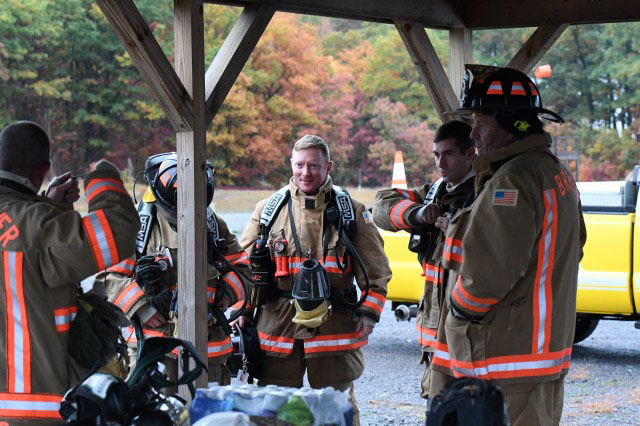
FORT DRUM, NY — With a room ablaze and dark smoke billowing out of the house, it would have been instinctive for the firefighters to immediately extinguish the fire.
Instead, first responders were asked to go inside, huddle up and talk.
“Don’t do anything,” said Fort Drum Assistant Fire Chief Randy Ketcham. “Just get in the fire room and let’s talk about the heat and the fire behavior, watch the fire flows and know that, even though it’s an aggressive atmosphere it doesn’t necessarily mean you’re in imminent danger. There’s time to use your head.”
“Move, communicate and learn” were the objectives of a mutual aid nighttime live fire training event Sept. 29 for nearly 30 firefighters from the Fort Drum Fire and Emergency Services Division and Black River Volunteer Fire Department.
Ketcham said that the joint training was meant to be a learning experience, and one that firefighters don’t often have a chance to do.
“Usually when we are doing this, it’s for real, and we’re moving so fast that there is not a lot of learning happening,” he said. “This is where the learning happens.”
Specifically, the learning happened inside a two-story structure at the Fort Drum Fire Department Training Center at Wheeler-Sack Army Airfield. The training house has two burn rooms and eight additional bedrooms with removable doors, and a smoke system that can be used to simulate upstairs and basement fires.
“The training fire consists of Class A material which, for these purposes, we use pallets and hay,” Ketcham said. “It smokes up real nice and makes your visibility go down to about zero. We also try to make it loud in there. When it’s truly hard to communicate and difficult to see, you really have to fall back on your training at that point in order to negotiate the floor plan and move your crew.”
But Ketcham said that there is a limit to how hot they make the fires during a training event.
“This isn’t meant to replicate an actual fire incident,” he said. “You don’t really want to create that type of environment to train in. You just want enough to be able to identify some of the fire behavior, see the thermodynamics at work – the thermal layering, the volume, velocity, density, and color of the smoke and the flow paths of the super-heated gases.”
This doesn’t imply that the training is easy, Ketcham added.
“Firefighting is a team sport,” he said. “If you’re not a team, you’re not going to be successful. We try to make the training as difficult as we can for them, so they are successful when it matters most.”
Ketcham said that firefighting gear provides so much protection that it can create a situation where a firefighter isn’t fully aware of potential danger.
“So, we teach people how to test their environment and stay aware of their environment,” he said. “We’ll get them really warm in there, and then I’ll make them flex their gear, because that makes everything touch your skin.”
Ketcham said that a firefighter’s experience enables them to determine risk factors when saving lives and property.
“You can read a book and take a class, but you can’t teach experience,” he said. “That’s why we’re out here – to get that experience.”
Lt. Col. Paul Shepard works in the Directorate of Plans, Training, Mobilization and Security, and has volunteered with the Black River Fire Department for nearly three years. He previously served at a local fire department while stationed at Fort Knox, Kentucky.
“The fire service has been an outstanding opportunity to volunteer in my community,” Shepard said.
Fort Drum and Black River firefighters teamed up for search-and-rescue earlier in September, so this was the second time Shepard has participated in mutual aid training with Fort Drum FES.
“All of the training provided through the combined efforts of Black River Fire and Fort Drum Fire has been tough and realistic,” he said. “It has been an outstanding experience working with the team at Fort Drum Fire.”
Shepard said that the combined training events enabled the Black River crew to build on their foundational training and reinforced skills they employ while supporting the local community. He credited Fort Drum FES for organizing a safe, professional training environment that benefited both agencies.
“The incident command post run by Fort Drum Fire was executed in a very efficient manner, and built a great deal of confidence for me, as I was able to observe senior officers and participate in the live burn training,” Shepard said.
Fort Drum FES maintains mutual aid agreements with the three counties that surround the installation – Jefferson, Lewis and St. Lawrence. The cooperation between on-post and off-post agencies ensures a rapid response to emergencies to enhance the safety and security of all community members.
In the past 12 months, Fort Drum FES responded to 45 requests for firefighting support in Jefferson County and received mutual aid support four times for fire incidents on post.
“Ultimately that’s why we’re out here – to improve our interoperability between the two agencies and exercise our mutual aid agreement,” Ketcham said. “We want to be as familiar as we can working with each other, so they can see what we are capable of and we can see their capabilities.”




